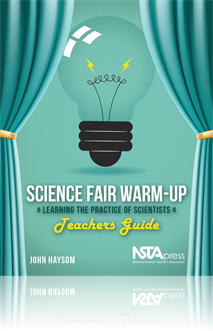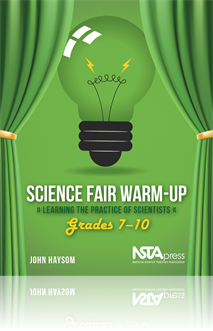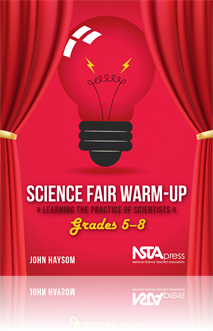All Resources
Book Chapter
This chapter is about graphing data. The three lessons are designed to develop the students' awareness of the value and techniques of graphing by providing an overview of graphing rather than a comprehensive course in graphing skills....
Book Chapter
The Numbers Game: Are Some Measures Better Than Others?
In this chapter, readers see how Marie and Monique want to make the strongest magnet possible and had various ideas for how to do so. They wonder whether the number of times you stroked the tube made a difference. They wonder whether the size of the ...
Book Chapter
As you work on a project, students will meet all sorts of problems: problems with measuring, designing apparatus, devising good investigations, graphing, making sense of what you have discovered. Students can get help with these problems from friends...
Book Chapter
This chapter focuses on the products of scientific inquiry. It relates the product of inquiry to the process of inquiry and presents scientific activity as a human endeavor motivated by the desire to produce valuable products. It portrays scientific ...
Book Chapter
This chapter is about sharing and communicating scientific findings. It is designed to help students who have done a project to display it, write it up, and talk about it. It attempts to put this exercise in the context of how the community of scient...
Book Chapter
The first lesson in this chapter focuses on judging displays, the second on judging written reports, and the third on judging oral presentations. The lessons may also be considered a review of what students have learned. To help them make judgments, ...
Book Chapter
This chapter is designed to help students generate ideas for an investigation of their own and serves as a launching pad for science fair and science project work. Although this is the last chapter, some teachers may choose to use it first. The three...
Book Chapter
An Overview of the Nature of Scientific Inquiry: Beginner Scientists and Experienced Scientists
This chapter presents a project on puddles and understanding more about evaporation and the way nature behaves. Over the years, scientists have learned a lot and have made important contributions on how the rate of evaporation is affected by the size...
Book Chapter
Science Without Numbers: Wondering Why
The chapter suggests making a paper helicopter and find out as much as you can about it in 30 minutes. Record the findings and then begin working in the same way on a project of your choice. You’ll find that one experiment leads to another as you ...
Book Chapter
The Numbers Game: Learning to Play the Numbers Game
This chapter focuses on how our senses can deceive us by investigating the question, “Which line is longer?” Everyone was deceived! Scientists invent new instruments and are often very creative. For example, one way to measure the brightness of a...
Book Chapter
Variables and Their Controls: Being Fair
To create a fair test, all the conditions (variables) must be kept the same (constant) except for the variable being investigated. Scientists call this type of investigation a controlled investigation. They try to find out what variables make a diffe...
Book Chapter
Experiment Design: Getting Experiments to Work: Repeatability
This chapter features five investigations from Starting Points presented in Chapter 1 and gives a scenario of “the test of a fair test” for each. If a test is a fair test, it is expected to be repeatable. This is important and scientists often ch...
Book Chapter
Sources of Error: Taking the Average
This chapter focuses on sources of error and taking the average. If an investigation is done five times with different readings each time, what could make the difference and which result is most accurate? The average will give the “best” answer,...
Book Chapter
Making Sense of Your Results: Charting Your Data
Can you imagine the world without clocks? It was 400 years ago that Galileo got his idea for the first pendulum clock by watching the lamp in the dome of the cathedral swing back and forth with an even rhythm. The task in this chapter is for student...
Book Chapter
Explanations: Looking for Patterns and Trends: Generalizing
This chapter features projects where you look for patterns and trends. The success of a project depends on whether or not the findings are valuable—whether you have discovered some generalizations—in addition to its being well done scientifically...
Book Chapter
Sharing Your Findings: Displaying Your Project
This chapter provides a simple pattern for making display boards and pictures of displays are found in the book. There is no recipe for a great display because every project is different. It’s a real challenge to find an attractive, clear, and conc...
Book Chapter
Judging Projects: Checking for Quality
It’s not easy to judge projects. Every project is different and must be judged on its own merits. Some projects are straightforward, while others are demanding. This chapter asks that students be the judge by carefully reading the actual accounts ...
Book Chapter
Generating Ideas for Projects: Ideas From Previous Science Fairs
This chapter shares a list of titles of projects at a national science fair to give students some indication of the range of topics. A good way to explore a topic is to discuss it with a friend. When exploring a topic, remember it’s okay to choose...
Book Chapter
It’s not easy to tell what science fairs and science projects are all about. The best way to find out is to do a project and take it to a science fair. This chapter provides “starting points” for projects and these “starting points” have be...
Book Chapter
An Overview of the Nature of Scientific Inquiry: What Do Scientists Do?
This chapter explores the question, “What do scientists do?” A good way to find out what scientists do is to try being a scientist. The chapter presents a challenge to students with an exercise on falling objects. It isn’t easy to make sense of...
Book Chapter
Science Without Numbers: Looking for Similarities and Differences
This chapter presents the task of students finding out all they can about the soil by looking for similarities and differences. This task allows students to experience a little of the difficulty and puzzlement the early chemists faced centuries ago a...
Book Chapter
Variables and Their Controls: Finding Out How Much It Matters
In this chapter, students are asked to be a ramp design consultant and to devise a test rig using a toy racetrack and a ball. They need to determine the best angle for the ramp and think about what makes a fair test. The angle could be difficult to ...
Book Chapter
Experiment Design: Designing Good Apparatus
This chapter presents the task of judging bubble solutions to see which makes the biggest bubbles and the longest-lasting bubbles. Students design and carry out a scientific experiment to decide which bubble solution is better. This is a real challe...
Book Chapter
Sources of Error: Searching for Errors
This chapter investigates suffocating candles and how long a candle stays lit in jars of different sizes. The students’ task is to try to find out what the uncontrolled variable is and how to control the variable, while using their knowledge and ex...
Book Chapter
Making Sense of Your Results: Graphing Your Data
This chapter features two projects—one on the science of table tennis and one on exploring the best way to stop needles from falling off Christmas trees. The focus is on “graphing the data,” and the decisions that need to be made, such as bar ...
Book Chapter
Explanations: Getting Explanations That Fit
This chapter deals with “getting explanations that fit.” When scientists do experiments, they try to explain their findings by connecting the results to what they already know. When they encounter a new happening—or phenomena—they try to fit ...
Book Chapter
Sharing Your Findings: Writing Your Report
After scientists have done an experiment or a series of experiments, they usually take time to write their reports. This not only gives them a chance to get their thinking together but also—and even more important—enables them to share their wor...
Book Chapter
Judging Projects: Suggesting Improvements
This chapter focuses on “suggesting improvements.” When a scientist sends a report of an investigation to a journal for publication, the editor consults experts on whether the investigation was done well and if the findings are valuable. The expe...
Book Chapter
Generating Ideas for Projects: Ideas All Around You
Some of the best science fair projects can be found right in the world around you. These projects are found when you start looking at cooking, gardening, and TV commercials from a scientist’s perspective. The best way for brainstorming ideas is to...
Book Chapter
Science fair projects are about real problems that you choose to explore. The problems are challenging and fun. The best way to find out what science fair projects are all about is to do a project and take it to a science fair. This chapter provides ...
Book Chapter
The wing of a bat, the bone in your leg, the stem of a plant—all have elegant, elaborate structures. Scientists would like to understand how and why these structures developed and engineers are also concerned with developing an understanding of str...
Book Chapter
Science Without Numbers: Searching for Patterns
Searching for patterns is often the very beginning of sense making. We do it all the time. Scientists try to find patterns in their observations, then understand how these patterns are connected. For example, the way you go about cracking a code is s...
Book Chapter
The Numbers Game: Designing Your Own Measures
Have you ever wondered how people managed before the ruler and the clock were invented? Today, scientists use the metric system of measurement—one based on the meter, kilogram, and second. It is a decimal system. To measure length, normally a ruler...
Book Chapter
Experiment Design: Preparing Experimental Designs
This chapter focuses on turning cooking into a science. A cookie recipe is shared with students along with a list of questions to consider. Students are also invited to develop the recipe. If scientists were given a recipe to develop, they would t...
Book Chapter
Sources of Error: Sampling: An Introduction
Sampling is a technical matter—it has to be planned carefully. The accuracy and reliability of the results are calculated using statistics. For example, the connection between high salt consumption and high blood pressure was established using stat...
Book Chapter
Making Sense of Your Results: Interpreting Graphs
Graphs can tell a story and are like a silent interpreter. They give meaning to numbers and turn numbers into pictures, but words still need to be input. This chapter presents the case of the bean seed planted in a glass jar so that growth is visible...
Book Chapter
Explanations: Deepening Your Understanding: Analogies and Models
This chapter highlights the project—“The Right Nail for the Right Job”—and extends the understanding of the behavior of wood and nails. Scientists often use analogies to extend their understanding. Analogies help to “see” things in an ext...
Book Chapter
Sharing Your Findings: Talking About Your Project
After finishing investigations or experiments, scientists frequently present their findings at a conference. If their presentations are well received, scientists are then encouraged to send the papers to scientific journals for publication so they ca...
Book Chapter
Judging Projects: Making Judgments
Scientists often put themselves in other scientists’ shoes to make judgments by saying “if I had been doing that piece of research, what would I have done?” Making judgments involves making such comparisons. In this way, scientists learn from o...
Book Chapter
Generating Ideas for Projects: Ideas From the Scientific Literature
Scientists keep in touch with one another by writing about their experiments in journals. These are the original sources of information that spread quickly to others through science magazines, newspaper reports, and television programs. Information i...






